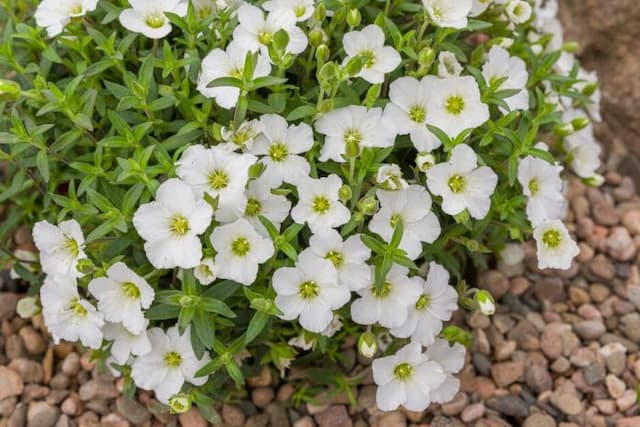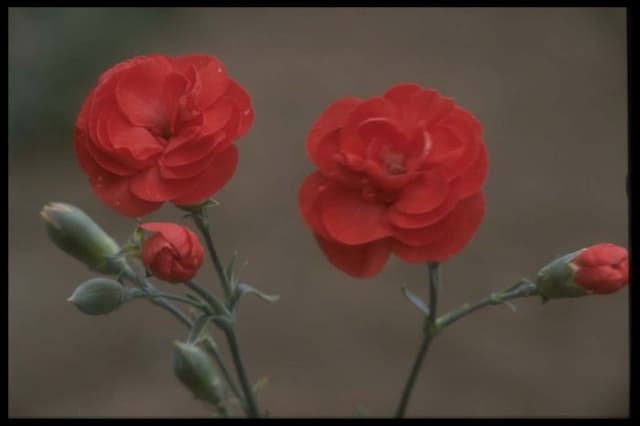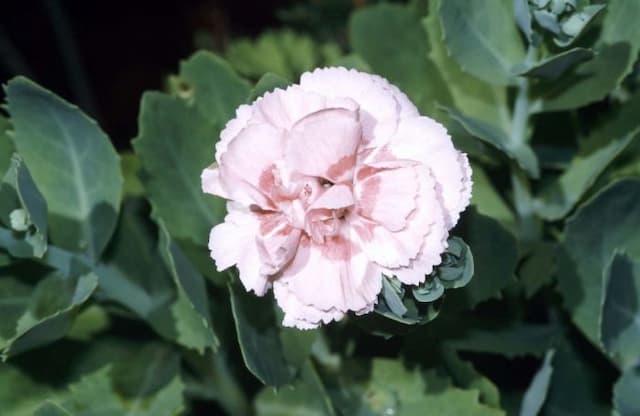Albanian Pink Dianthus myrtinervius

ABOUT
The plant known most commonly as Dianthus features slim, bluish-green leaves that fashion a compact mound or tuft-like formation. These leaves are typically elongated and might feel slightly grassy to the touch. Atop these mounds sit the eye-catching flowers, which tend to ooze charm with a rich array of colors including pinks, reds, and whites. These blossoms boast a distinctive frilled edge that gives them a ruffled appearance, often likened to the edges of classic pinking shears. The petals may exhibit a variety of patterns such as solids, bicolors, or speckles, and commonly convey a delicate, clove-like fragrance that wafts through the air, especially during the morning and evening hours.
About this plant
 Names
NamesFamily
Caryophyllaceae
Synonyms
Myrtle-Leaved Dianthus
Common names
Dianthus myrtinervius.
 Toxicity
ToxicityTo humans
Dianthus myrtinervius, commonly known as the Myrtle-nerve Pink, is not widely recognized for having significant toxicity to humans. Most Dianthus species are considered safe and are commonly used in gardens and landscaping without serious concern for human health. However, it is generally advisable to avoid ingesting plants that are not specifically grown for consumption, as they can cause gastrointestinal discomfort or allergic reactions in some individuals. If Myrtle-nerve Pink were to be poisonous, which is typically not the case, symptoms of poisoning could potentially include nausea, vomiting, diarrhea, and abdominal pain. It's important to note that any part of a plant could contain toxins; therefore, caution should be exercised and plants not intended for consumption should generally not be eaten.
To pets
Dianthus myrtinervius, or Myrtle-nerve Pink, is not commonly associated with toxicity in pets. Dianthus species are often used ornamentally and are not known to be particularly harmful to animals. However, as with any non-food plant, if pets consume large quantities of this plant, there is a risk of mild gastrointestinal upset, manifesting as symptoms such as vomiting or diarrhea. Ingesting plant parts can also potentially lead to an allergic reaction, though such occurrences are relatively rare. Pet owners should still prevent their pets from eating ornamental plants as a precautionary measure, as individual animals could have unique sensitivities or allergies.
 Characteristics
CharacteristicsLife cycle
Perennials
Foliage type
Evergreen
Color of leaves
Green
Flower color
Pink
Height
1 foot [30 cm]
Spread
1 foot [30 cm]
Plant type
Herb
Hardiness zones
8
Native area
Europe
Benefits
 General Benefits
General Benefits- Aesthetic Appeal: Dianthus myrtinervius adds vibrant color and texture to gardens with its vivid blooms and distinctive foliage.
- Pollinator Attraction: The flowers attract beneficial pollinators like bees and butterflies, supporting local ecosystems.
- Low Maintenance: As a hardy plant, it requires minimal care once established, making it suitable for various garden styles.
- Drought Tolerance: This species is known to withstand periods of drought, reducing the need for frequent watering.
- Long Blooming Period: It has a lengthy flowering season that can keep your garden colorful from late spring to early fall.
- Ground Cover: Its growth habit makes it an excellent choice for ground cover, helping to suppress weeds and reduce soil erosion.
- Fragrance: The flowers often exude a pleasant fragrance that can enhance the sensory experience in a garden or landscape.
- Cultural Significance: Some Dianthus varieties are associated with traditional events and customs, potentially giving Dianthus myrtinervius cultural relevance.
 Medical Properties
Medical PropertiesThis plant is not used for medical purposes.
 Air-purifying Qualities
Air-purifying QualitiesThis plant is not specifically known for air purifying qualities.
 Other Uses
Other Uses- Culinary garnish: The flowers of Dianthus myrtinervius can be used to embellish salads and desserts, adding a splash of color with their bright blossoms.
- Textile dye: Historically, the flowers and stems, rich in pigments, could be used to dye fabrics in various shades of pink and red.
- Artistic inspiration: The striking appearance of Dianthus myrtinervius makes it a favored subject for botanical illustration and garden photography.
- Companion planting: This plant can be beneficial in a garden as it may attract pollinators, aiding in the pollination of surrounding plants.
- Eco-friendly confetti: Dried petals of Dianthus myrtinervius can be used as a biodegradable confetti option for celebrations.
- Scented sachets: The flowers can be dried and used in sachets to naturally scent drawers and closets.
- Floral arrangements: Fresh or dried, these flowers provide an attractive addition to bouquets and table centerpieces.
- Natural pest repellent: Some gardeners use Dianthus myrtinervius among their vegetables to help ward off certain pests with its scent.
- Crafting potpourri: The fragrant petals are often included in homemade potpourri blends.
- Symbolic gift: In some cultures, giving this plant as a gift could symbolize love and admiration, akin to a more eco-friendly alternative to the traditional rose.
Interesting Facts
 Feng Shui
Feng ShuiThe Dianthus is not used in Feng Shui practice.
 Zodiac Sign Compitability
Zodiac Sign CompitabilityThe Dianthus is not used in astrology practice.
 Plant Symbolism
Plant Symbolism- Durability: Dianthus, often known as "pinks," are associated with durability because they are hardy perennial plants that survive and thrive across many growing conditions.
- Divine Love: In the language of flowers, Dianthus can symbolize divine love, as the name 'Dianthus' itself comes from Greek words 'dios' (god) and 'anthos' (flower).
- Pure Love: The blooms of the Dianthus are often used to express pure and ardent love, especially since the flowers have a timeless, classical feel to them.
- Admiration: The vibrant and textured appearance of Dianthus flowers often carries the symbolic meaning of admiration and can be gifted to express respect for someone's grace and dignity.
 Water
WaterThe Sweet William, as Dianthus myrtinervius is commonly known, prefers soil that is consistently moist but well-drained. It should be watered thoroughly whenever the top inch of soil feels dry to the touch. Depending on the weather conditions and the size of the plant, this usually means providing about 1 gallon of water per plant every week during the active growing season. During periods of high heat or drought, the frequency may need to increase to ensure the soil doesn’t dry out completely.
 Light
LightSweet William thrives in a location with full sun to partial shade. The ideal spot would offer at least six hours of direct sunlight daily, ensuring that the plant receives ample light for vigorous growth and abundant flowering. While it can tolerate light shade, too much shade can lead to sparse blooms and a leggy growth habit.
 Temperature
TemperatureThe Sweet William, prefers a temperate climate and can survive in temperatures ranging from 40 to 85 degrees Fahrenheit. However, ideal growth occurs when the temperature consistently stays between 60 and 70 degrees Fahrenheit. It can withstand short periods of colder temperatures down to about 20 degrees Fahrenheit but should be protected from prolonged exposure to freezing conditions.
 Pruning
PruningPruning Sweet William is essential for maintaining a bushy and vigorous plant. Deadheading, or removing spent flowers, promotes further blooming throughout the season. After the main bloom, cut back the stems to encourage a tidy shape and potentially a second smaller bloom. The best time for a more substantial pruning is early spring or after the last frost, when growth is just resuming.
 Cleaning
CleaningAs needed
 Soil
SoilSweet William's Catchfly (Dianthus myrtinervius) thrives in well-draining soil with a mix of two parts garden soil, one part sand or perlite, and one part organic compost. Soil pH should be slightly alkaline, ranging from 7.0 to 7.5.
 Repotting
RepottingSweet William's Catchfly should be repotted every one to two years or when it outgrows its current container to ensure continued health and growth.
 Humidity & Misting
Humidity & MistingSweet William's Catchfly prefers average to low humidity levels, consistent with typical household conditions; it does not require high humidity.
 Suitable locations
Suitable locationsIndoor
Place in bright, indirect light; well-draining soil mix.
Outdoor
Full sun to partial shade; moist, well-draining soil.
Hardiness zone
5-9 USDA
 Life cycle
Life cycleDianthus myrtinervius, commonly known as the Alpine Pink, starts its life cycle from seeds that germinate in well-drained, slightly alkaline soil under full sunlight or partial shade. Upon germination, it develops a rosette of narrow, green leaves, and as the plant matures, it establishes a strong root system. The Alpine Pink then enters a vegetative stage where it focuses on leaf production in preparation for flowering. Flowering occurs in late spring to summer, exhibiting small, pink to purplish flowers, each with five petals that are often fringed at the edges, attracting pollinators for sexual reproduction. After pollination, seeds develop in small capsules and, once mature, are dispersed by wind or small animals, which then can grow into new plants if conditions are favorable. During harsh conditions or off-seasons, Dianthus myrtinervius may enter a period of dormancy, with growth and metabolic activities reduced until favorable conditions return.
 Propogation
PropogationPropogation time
Spring-summer
The most popular method of propagation for the Dianthus myrtinervius, often referred to as the Pink, is through stem cuttings. This technique is particularly effective during the growing season, typically in late spring or early summer when the plant is actively growing. To propagate Pink using stem cuttings, a gardener should select a healthy, non-flowering stem and cut a segment about four to six inches long, making sure there are at least three sets of leaves on the cutting. The cut should be made just below a leaf node, as this is where roots are most likely to develop. The lower leaves are then removed, and the cutting is dipped in rooting hormone powder to encourage root growth. Afterward, the cutting is placed in a well-draining potting mix, ensuring that at least two leaf nodes are buried in the soil. The pot is kept in a warm, bright location out of direct sunlight and the soil is kept moist but not waterlogged, allowing the cutting to root usually over the course of several weeks.



![Pink [Tequila Sunrise]](/_next/image?url=https%3A%2F%2Fplants-admin.emdemapps.com%2Fimages%2Fplants%2F%2Fimages%2F604b5d995d06e.png&w=640&q=75)





